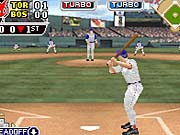Anyone who's familiar with Midway's sports franchises--NBA Jam, NFL Blitz, and NHL Hitz--knows what to expect from a game titled MLB Slugfest. On the current-generation consoles, MLB Slugfest 2004 is an exciting combination of baseball and boxing. Players can punch the ball out of a fielder's glove and use the turbo meter to improve various aspects of their game. The pitcher can even bean batters to diminish the batter's stats. MLB Slugfest 2004 on the Game Boy Advance has only a few of these features, and they're all poorly implemented to boot.

To be fair, Midway never claimed Slugfest was a simulation. In the console versions, much of the action occurs on the base paths. You can activate a turbo boost to run faster and pummel a fielder to knock the ball loose from his glove. On defense, the pitchers in the console versions can bean batters in an attempt to decrease the batter's stats, although there's always the risk that the batter will turn hot and improve instead. None of these things are implemented properly in the GBA game. Base runners can't attack fielders and bean balls always set the batter on fire. You can have fielders punch base runners, but this is the only remnant of the console versions' fisticuffs--and it has no effect, anyway.
The number of available play options is also somewhat limited. You can play exhibition games, participate in a playoff series, or take on all 30 teams in an abbreviated season. Unlike in other baseball games on the GBA, you can't play a full season, trade players, fool around in a home run derby, or play against your friends using a link cable.
Even though MLB Slugfest 2004 is terrible in most respects, the graphics are at least decent. The game includes six different ballparks: Wrigley Field, Pacific Bell Park, Fenway Park, Safeco Field, Yankee Stadium, and Coors Field. In the batting viewpoint, the stands and scoreboards look exactly like they would in the actual venue. The tiny fielders twitch from side to side in anticipation of a hit. Once the ball is in play, the field is shown from an overhead viewpoint. The dimensions for each park, including the looks of the lines and walls, are accurate. You can't make out the faces or numbers of specific players, but the animations when they run and throw the ball are fairly smooth.

Overall, MLB Slugfest 2004 on the GBA is a major disappointment. It lacks the unpredictability and mayhem of the console versions, as well as most of the features that you'd expect to find in a traditional baseball game.